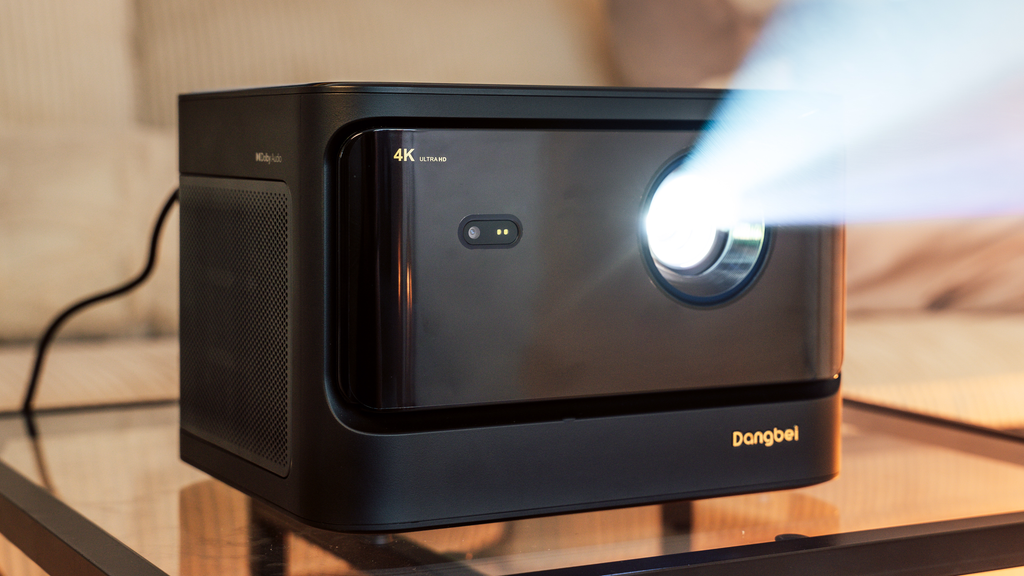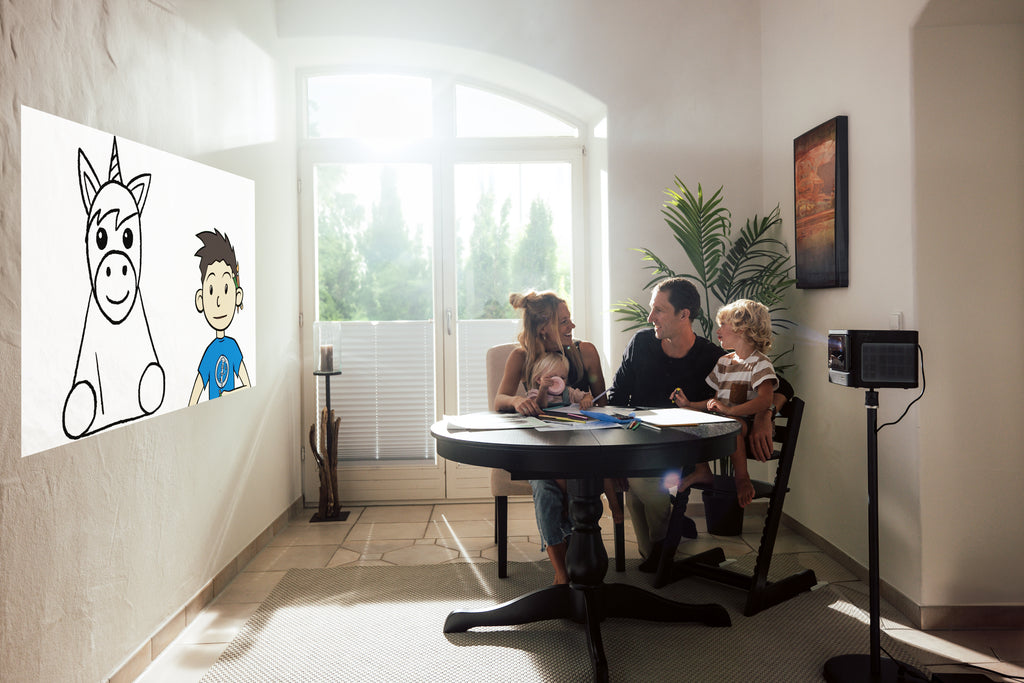No Products in the Cart

Projector resolution is an important factor for many consumers to consider when purchasing a projector. Two common resolutions for smart projectors are 1080p and 4K. 1080p refers to a resolution of 1920 x 1080 pixels, while 4K refers to a resolution of 3840 x 2160 pixels. 4K offers four times as many pixels as 1080p, resulting in notable differences in image clarity and detail between the two.
In this blog, we’ll compare 1080p and 4K projectors, looking at the differences in resolution, level of detail, ideal screen sizes, and overall benefits of both to help identify the best use cases for each.
The most basic difference between 1080p and 4K projectors is in the resolution, or the number of pixels used to create the projected image.
1080p has a resolution of 1920 x 1080 pixels. This results in over 2 million pixels per image. 4K has a much higher resolution of 3840 x 2160 pixels. This equates to over 8 million pixels per image, which is four times as many pixels as a 1080p image.
The more pixels in an image, the more detail and clarity it can provide. Just as a higher megapixel camera can capture more detail, a higher resolution projector can project images with finer details and less pixelation, especially at larger screen sizes.
The higher resolution of 4K projectors allows them to produce a sharper, more detailed image compared to standard 1080p projectors.
Fine details in images, text, and videos will be more discernible and less pixelated on a 4K projector. This applies to any content being projected, whether it’s movies, sports, video games, text documents, or images.
Elements like hair, fabric textures, or individual leaves on trees will be more lifelike and realistic looking with the extra detail of 4K. Scenes with intricate patterns, small text, or very fine details will particularly benefit.
1080p resolution will certainly display details as well, but may start to show more pixelation and less defined edges on larger screen sizes or very detailed imagery.
Screen size plays an important role in determining the ideal projector resolution. On larger screens, 4K resolution is generally recommended to provide enough detail without visible pixels. On smaller screens under 100 inches, 1080p resolution may still look very good.
As screen size increases, the benefits of 4K over 1080p become more apparent. Larger screens allow viewers to better appreciate the enhanced clarity and detail of the extra pixels. Sitting closer to a large 4K display remains comfortable for the eyes. On a large 1080p display, sitting too close makes pixelation more obvious.
This means that for screen sizes above 100 inches, 4K resolution offers more substantial benefits. But on smaller screens that viewers are further from, 1080p can still look fantastic.
Now that we’ve compared some core differences between 4K and 1080p projectors, let’s dive deeper into the specific benefits that 4K models provide:
One of the biggest benefits of 4K projectors is that their higher resolution remains effective even on very large screens above 100 inches. This allows viewers to create a truly immersive cinematic experience at home. The Dangbei Mars Pro is an excellent 4K laser projector that delivers on this immersive home theater promise. This projector can create a massive 200-inch image with stunning 4K clarity and picture quality.
On extra large screens, 4K resolution prevents visible pixelation and provides enough detail so viewers can sit closer to the screen. This maintains clarity and immersion. With 1080p projectors, large screens demand further viewing distance to prevent seeing pixels.

By producing images with over 8 million pixels, 4K projectors are able to create incredibly realistic, lifelike projected images. Fine details like skin texture, individual leaves, or stray hairs appear sharper and more natural.
This high degree of realism and detail improves the viewing experience for movies, sports, gaming, photographs, text, and more. It helps create an immersive entertainment environment.
More and more movies, TV shows, and games are being produced in 4K resolution each year. Media streaming platforms are also expanding their libraries of 4K content.
By choosing a 4K projector now, you are future-proofing your home theater for this growing shift toward 4K. A 4K projector will be able to fully take advantage of native 4K content for the best viewing experience.
A 1080p projector will still display 4K content, but by downscaling it to fit the lower 1080p resolution. This means not fully experiencing the details and clarity of native 4K footage on a 4K display.
Many 4K projectors also come with HDR support, which stands for High Dynamic Range. This allows the projector to display a wider range of color, contrast, and brightness levels compared to standard dynamic range on 1080p projectors.
HDR enables more realistic projections with bolder colors, intense contrasts between light and dark, vivid image depth, and truly bright whites and deep blacks. This takes full advantage of HDR-enhanced picture quality from sources like 4K Blu-ray or streaming platforms.
After looking at the many benefits of 4K resolution, let’s examine some of the advantages 1080p projectors still provide:
The main benefit of 1080p projectors is that they cost notably less than 4K models. Prices vary, but 1080p projectors can retail for $500 - $1500 less than comparable 4K projectors. For buyers on stricter budgets, 1080p provides substantial savings.
Many reasonably priced 1080p projectors still offer excellent color accuracy, brightness, and contrast for an immersive projected image. While not 4K, their resolution is still high definition at a more accessible price point. One great example is the Emotn N1 Netflix 1080p projector. This native 1080p LED projector has built-in streaming apps like Netflix and is very attractively priced under $400, giving you an immersive home theater experience on a budget.

As mentioned earlier, the benefits of 4K over 1080p are more pronounced on larger projection screens. For setups with smaller screens under 100 inches, a 1080p projector is likely sufficient.
On a smaller screen that users are sitting further from, the bump up to 4K resolution will be less noticeable. The visible pixels and level of detail at 1080p will still please audiences.
While 4K content is certainly growing, the majority of media, movies, TV shows, and more are still produced in 1080p or lower resolutions. 1080p projectors are well equipped to display this abundant existing content.
Streaming platforms also tend to favor higher compression and lower resolutions on most titles. A 1080p projector easily keeps up with common 1080p streaming quality.
Based on the benefits above, here are some of the most common use cases where a 1080p projector may sufficiently meet customers' needs:
Smaller screen sizes: For compact home theater spaces better suited to screens in the range of 50 to 100 inches, a 1080p projector will provide pleasing resolution without breaking the bank.
Rooms with less ambient light: 1080p projectors perform especially well in dedicated home theaters with full light control. Their resolution holds up better in dark rooms where vivid colors and deep blacks create immersion. Brighter environments put more strain on resolution.
Streaming 1080p content: Those who primarily watch online streaming services will be well served by a 1080p projector. Most content on platforms like Netflix, Hulu, Prime Video is 1080p quality or lower.
Purchasers on a tight budget: If affordability is the top priority, there are quality 1080p projectors available for under $1000. This allows buyers to save money over 4K models while still enjoying projected visuals.
In contrast, here are some of the top situations where splurging for a 4K projector is worthwhile:
Larger screen sizes over 120 inches: To fully take advantage of very large wall-sized screens, 4K provides the resolution needed for immersive viewing without pixelation up close.
Very bright rooms or outdoor: Brighter rooms make pixelation more noticeable. 4K helps counteract this to maintain clarity even in living rooms or outdoor spaces. 1080p starts to struggle with ambient light.
Viewing 4K media content: For movie buffs or gamers who watch substantial 4K Blu-ray or streaming content, a 4K projector enables getting the most out of these sources' enhanced clarity and colors.
Future-proofing and longevity: 4K projectors offer more longevity moving forward as 4K becomes standard. This prevents the need for another upgrade cycle when 4K dominates.
When it comes to 1080p vs 4K projectors, both technologies have their benefits depending on customers' needs and use cases. 1080p projectors offer strong value and performance for smaller screen sizes, particularly under 100 inches. 4K projectors’ higher resolution provides the level of detail and clarity needed for truly immersive projected visuals on extra large displays. As 4K content becomes more prevalent across movies, TV, and gaming, 4K projectors will be capable of fully leveraging these enhancements.
For most buyers, taking into account screen size, viewing environment, and content needs will determine whether 1080p or 4K is the better choice. Carefully evaluating your room setup, viewing habits, and budget will help you decide on the ideal resolution for your next home theater projector.
Q: What is the resolution of 1080p and 4K?
A: 1080p resolution is 1920 x 1080 pixels. 4K resolution is 3840 x 2160 pixels. This means 4K offers over 8 million pixels per image, 4 times more than the 2 million pixels in 1080p.
Q: Can a 1080p projector play 4K content?
A: Yes, 1080p projectors can play 4K content. However, the 4K source will be downscaled to fit the 1080p resolution of the projector. This means not fully experiencing the enhanced clarity and details of native 4K footage.
Q: What size screen do I need for 4K?
A: To fully appreciate the benefits of 4K resolution, screen sizes over 100 inches are ideal. On large screens, 4K provides enough detail for close-up viewing without visible pixels. Smaller screen sizes under 100 inches can still look great with 1080p.
Q: Is 4K worth the higher cost over 1080p?
A: 4K is worth the price premium for large screen home theaters over 100 inches, very bright rooms where pixelation is an issue, or for viewers who watch a lot of native 4K content. For smaller screens or budget setups, 1080p is likely sufficient.